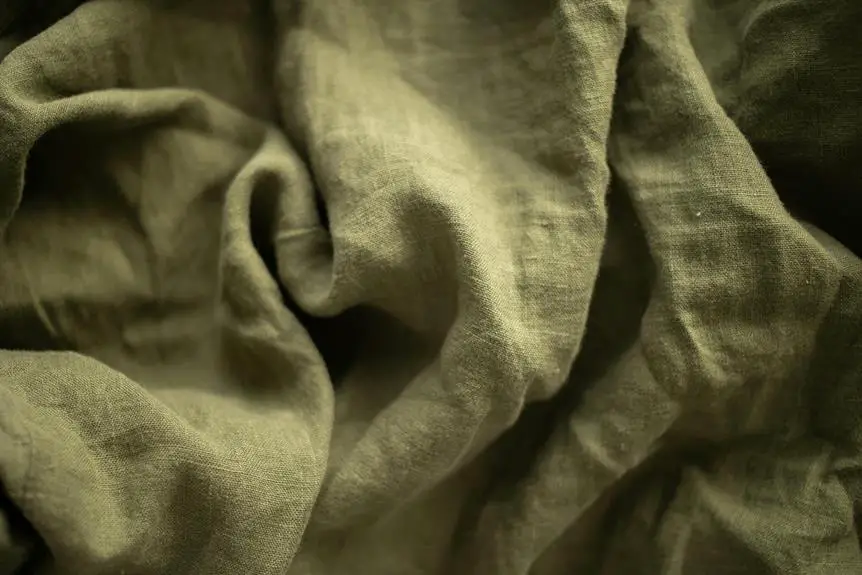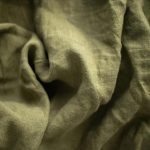When you're dealing with fabric creasing, it's essential to consider several factors that contribute to this issue. The fiber composition, weave, and even how you wash and store your fabrics can significantly impact their tendency to wrinkle. You might be surprised to learn that environmental conditions also play a role in how your garments behave over time. Understanding these elements isn't just about maintaining appearance; it can influence the longevity of your textiles. So, what practical steps can you take to minimize creasing effectively?
Table of Contents
Key Takeaways
- Natural fibers like cotton and linen crease more easily due to their flexible structure compared to synthetic fibers like polyester.
- Looser fabric weaves allow for more movement, resulting in increased wrinkling, while tighter weaves create smoother surfaces.
- Washing techniques, including overloading machines and high heat drying, contribute to fabric creasing through increased friction.
- Environmental factors like high humidity and poor airflow can lead to moisture absorption, causing fabrics to wrinkle.
Fabric Composition and Structure
When you examine fabric composition and structure, you'll discover how these elements directly influence creasing tendencies. Different fibers react uniquely to stress and pressure, affecting how they hold wrinkles. For instance, natural fibers like cotton and linen tend to crease more easily because their structure allows for greater flexibility. In contrast, synthetic fibers such as polyester often resist creasing due to their more rigid molecular structure.
Moreover, the weave of the fabric plays a significant role. Tight weaves generally create a smoother surface that can deter creasing, while looser weaves might allow for more movement, leading to greater wrinkling. Fabrics with a blend of different fibers can also present varying creasing tendencies, depending on the dominant material.
The weight of the fabric is another factor to consider. Heavier fabrics tend to drape better and are less prone to creasing compared to lighter ones.
Lastly, the finish applied to the fabric—like a wrinkle-resistant treatment—can significantly mitigate creasing. Understanding these aspects of fabric composition and structure helps you make informed choices when selecting materials for your wardrobe, ensuring you stay wrinkle-free.
Washing and Drying Techniques
Proper washing and drying techniques are crucial for minimizing fabric creasing and maintaining the appearance of your clothes.
Start by sorting your laundry according to fabric type and color. This helps prevent damage and ensures more effective cleaning. When washing, use the appropriate cycle for each fabric; delicate fabrics benefit from gentle cycles, while sturdier materials can handle regular settings.
Don't overload the washing machine, as this can cause clothes to rub against each other, leading to more creases. Use a good quality detergent and consider adding a fabric softener, which can reduce static and help fabrics relax.
When it comes to drying, you have options. If you're air-drying, hang your clothes flat or on hangers to prevent them from bunching up. If you're using a dryer, opt for a low heat setting and remove clothes while they're still slightly damp. This minimizes heat exposure and reduces creasing.
Storage Methods
Storing your clothes correctly can significantly reduce creasing and keep them looking fresh. When you take the time to organize your wardrobe, you can prevent unnecessary wrinkles from forming. Here are some essential storage methods to consider:
- Use Hangers: Hang garments like dresses, blouses, and trousers to maintain their shape. Choose padded or wide hangers to avoid shoulder marks.
- Fold Appropriately: For items like sweaters or t-shirts, folding is key. Use the “file” method—fold and stack clothes vertically in drawers to minimize creasing.
- Avoid Overcrowding: Don't cram clothes into your closet or drawers. This pressure can lead to wrinkles. Give each item enough space to breathe.
- Store in a Cool, Dry Place: Keep your wardrobe in a temperature-controlled environment. Humidity can cause fabric fibers to relax and create creases.
Ironing and Pressing Practices
Ironing and pressing your clothes correctly can make a world of difference in keeping them wrinkle-free and looking their best.
Start by checking the care labels on your garments; each fabric has its own ideal heat setting. Using the right temperature helps prevent damage and keeps your clothes in top shape.
Before you start, make sure your iron's plate is clean, as residue can transfer onto your fabrics. For delicate materials, consider using a pressing cloth to protect them from direct heat.
When you iron, work in sections, moving from the collar to the sleeves and down to the body. This method ensures you tackle every area without creating new creases. Always apply steam if your iron has that feature; it relaxes the fibers and makes ironing easier.
After pressing, hang your clothes immediately on hangers to maintain their smooth appearance. If you're dealing with stubborn wrinkles, try lightly spraying water on the fabric before pressing.
Lastly, don't forget to store your clothes properly; avoid overcrowding in your closet to prevent new creases from forming. Following these practices will keep your wardrobe looking sharp and fresh.
Environmental Factors
Environmental factors, like humidity and temperature, can significantly impact how fabrics crease and retain wrinkles, making it important to consider these elements when caring for your clothes. You mightn't realize it, but the environment around you plays a crucial role in maintaining the look of your garments.
Here are four key environmental factors to keep in mind:
- Humidity Levels: High humidity can cause fabrics to absorb moisture, leading to more wrinkles. In contrast, low humidity can dry out fabrics, making them stiff and prone to creasing.
- Temperature Fluctuations: Extreme temperature changes can affect fabric fibers, causing them to contract or expand, which may result in creasing.
- Airflow: Poor airflow in your storage area can trap moisture and heat, contributing to wrinkling. Ensure your clothes have enough space for air circulation.
- Sunlight Exposure: Direct sunlight can weaken fabric fibers over time, leading to creasing and fading. Store your clothes away from direct light to preserve their quality.
Frequently Asked Questions
How Does Fabric Weight Influence Creasing Tendencies?
Fabric weight affects creasing tendencies significantly. Heavier fabrics usually resist creasing better, while lighter ones tend to wrinkle easily. Choosing the right fabric weight can help you minimize the hassle of maintaining a smooth appearance.
Can Specific Dyes or Finishes Affect Creasing?
Yes, specific dyes or finishes can affect creasing. Certain treatments enhance fabric resilience, while others may make it more prone to wrinkles. Choosing the right combination can help maintain a smoother appearance in your garments.
What Role Do Fabric Blends Play in Creasing?
Fabric blends significantly influence creasing. You'll find that synthetic fibers often resist wrinkles better than natural ones. When you choose blends, consider how their unique properties can help maintain a smoother appearance throughout the day.
Does the Age of Fabric Impact Its Propensity to Crease?
Yes, the age of fabric does impact its propensity to crease. As fabrics age, they can lose elasticity and strength, making them more susceptible to creasing and less able to recover from wrinkles.
How Do Different Sewing Techniques Affect Fabric Creasing?
Different sewing techniques can significantly impact fabric creasing. For instance, using tighter stitches might create more tension, leading to increased creasing, while looser stitches generally allow the fabric to drape better and reduce creases.
- Tetron Fabric for Marine Applications: Durability and Use Cases - June 18, 2025
- Tetron Fabric for Outdoor Furniture: Weather Resistance and Care - June 18, 2025
- Tetron Fabric for Wall Coverings: Style and Application Tips - June 18, 2025





